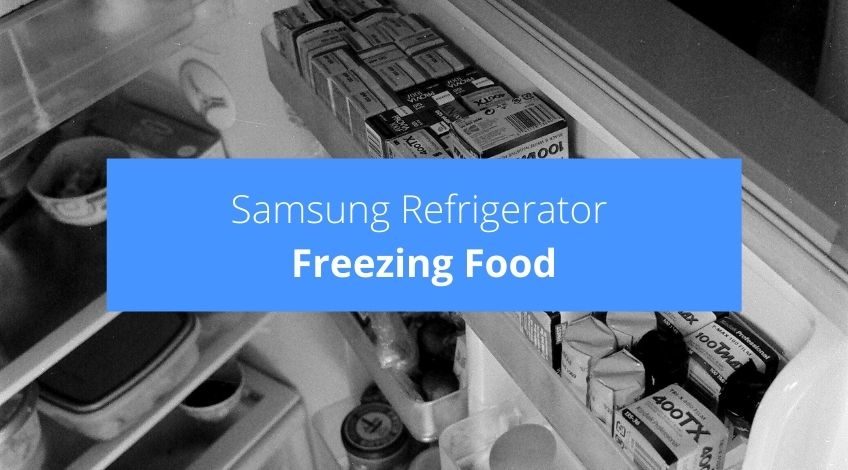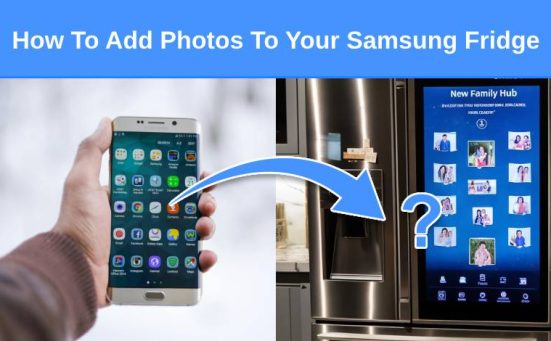
Samsung Refrigerator Freezing Food? (do this asap)
We all rely on our refrigerators to prevent our perishable foods from spoiling too quickly. Without the convenience of a refrigerator we would be forced to shop for our perishable foods daily. For the most part, we take the refrigerator for granted, we fill it with food and forget about it.
That’s why it’s such a big deal if it develops a fault, it throws our whole food storage into chaos. In this article we’ll look at why your Samsung refrigerator is freezing foods. We’ll highlight the reasons your fridge is freezing food and how to fix it too.
Check Refrigerator Door Is Properly Closed
You would think that if the refrigerator door was open the contents would get warm, not freeze. But the problem is the refrigerator senses the warm air, and sets about making it colder. Which in turn, causes the fridge to freeze in places.
Check For A Faulty Door Seal
If the fridge door is closed correctly, the problem could be the rubber door seal or gasket could be damaged or even just dirty. If there is a gap between the seal and the door, warm air will enter the fridge which will then work harder to chill the contents. Any high water content foods inside will succumb to the intense cold and freeze.
Check If The Thermostat Is Set Too Low
If the thermostat is set too low, the fridge will continue to cool which can lead to frost pockets forming in certain areas which will freeze some items in the fridge. The recommended temperature for a fridge is 38F (3C) if your fridge is set lower than this setting, it could be the cause of the freezing problem.
Check The Thermostat Is Working Correctly
The thermostat senses the temperature inside the fridge and sends messages to the compressor, condenser and evaporator to keep the fridge at an even temperature. If the thermostat develops a fault, there’s a breakdown in communication which can lead to food being too warm or freezing. The easiest way to check the thermostat is to wait until the compressor is running and then turn the temperature dial until it clicks.
That click should indicate the cooling system is shutting down if this happens, then the thermostat is operating correctly. Another way to test the thermostat is using a multimeter. Check the multimeter for continuity and if there is no continuity on any setting, then the thermostat needs replacing.
Turn Off “Power Cool” Function
The “power cool” function is designed to cool the contents of the fridge rapidly and is useful if the fridge hasn’t been used for a while. Or if the fridge has been filled with a large quantity of food and the desired temperature is a long way off. “Power cool” works by bypassing the fridge’s temperature settings and sending bursts of cold air into the fridge to chill it fast.
Check on the control panel to see if the “power cool” function has been selected. If it has, turn it off. To do this, hold the freezer button until the “power cool” icon goes out. If you have the Family Hub refrigerator you can manage “power cool” through the fridge manager app.
Check For Blocked Air Vents
If the air vents are blocked the fridge will sense there’s a poor air flow and work harder to force colder air into the cabinet to lower the temperature. This will eventually make the temperature of the fridge too cold and start to freeze the contents. The vents need at least a 2 inch clearance at all times.
The area around the air vents is the coldest part of the fridge because this is where all of the cold air enters the fridge. Foods with a high water content like meat and vegetables will be the first to freeze if they are placed too close to the air vents. You should also keep meats and vegetables away from the back and the bottom of the fridge as these are the coldest places and therefore most likely to freeze foods.

Reposition The Refrigerator
If your fridge is sited too close to a heat source, a radiator, cooker, hot air vent or even a sunny window, it could cause the contents to warm up. This would then cause the compressor and other parts of the cooling system to work harder to cool it down. This could lead to parts of the fridge becoming too cold and freezing the contents.
Conversely, if the room temperature is too low it could cause the interior of the fridge to become too cold and freeze some of the contents.
Store More Food
If the fridge settings and temperature controls are all working fine, you might need to add more contents in your fridge. This is because the more food in the fridge the better chance of the cool air being absorbed which reduces the chances of food freezing. Be careful not to overstock the fridge though, as this can have an adverse effect.
One way to fill the empty spaces in your refrigerator is to store bottled water in the fridge. Not only will this absorb the cold and prevent freezing. You will also have lots of cool, refreshing water available 24 hours a day.
Check The Thermistor
The thermistor’s function is to send the temperature readings to the control board. This allows the control board to send the correct power to the compressor and evaporator fan to regulate the temperature of the fridge. If the thermistor has developed a fault, it will send an incorrect reading which could result in the fridge freezing.
Check the thermistor is functioning correctly using a multimeter. Check the continuity and resistance. The resistance should alter in the same way as the fridge temperature changes, if it doesn’t and there’s no continuity, it’s time to replace the thermistor.
Keep The Condenser Coils Clean
The condenser coils release the heat of the refrigerant as part of the cooling process for the fridge. If the coils are covered in dirt, the heat can’t escape, which causes the refrigerator to produce even colder air to compensate for the extra condenser heat. This leads to the contents of the refrigerator freezing as the temperature drops too low.
Check The Air Damper
The air damper is a small unit with a flap that maintains the air flow from the freezer to the fridge. Usually located at the top of the fridge or on the back panel, the air damper is controlled via the thermostat. Which causes the air damper to open and close depending on the temperature of the air within the fridge.
If the air damper gets stuck in the open position, cold air from the freezer is constantly entering the refrigerator. Which will eventually turn into a second freezer. If it is stuck open the air damper will need replacing.
Check The Evaporator Cover For Ice
If there is a buildup of ice on the back of the evaporator cover it needs defrosting immediately to remove the ice and free the possible blocked drain tube. Once you have removed all of the ice, check that the defrost system is working correctly.
Defrost Fuse
To check the defrost fuse, use the multimeter to determine continuity if it’s working correctly, check the drain tube for any blockages.
Drain Tube
The drain tube allows water to escape the fridge, if it becomes blocked the water can’t escape and will just freeze which causes the contents of your fridge to get too cold and freeze.
Defrost Heater
If the defrost heater is faulty, there will be nothing to prevent ice from building up on the evaporator coils. Which can cause the fridge contents to freeze. Check the defrost heater using a multimeter.
Check The Control Board For Faults
As its name suggests, the control board controls all of the functions of your refrigerator. If it develops a fault, it could result in the contents of the fridge freezing. It’s difficult to test the control board, if you suspect the fault lies with the control board you’d best contact an electrical engineer.
How To Prevent Ice Buildup On A Samsung Refrigerator
To prevent any ice building up, you can use the force defrost setting. Depending which model Samsung refrigerator you own you can select force defrost by pressing a couple of buttons. Consult your user manual for model specific instructions or check out our article on the Samsung ice maker won’t come out which lists all of the relevant actions needed to instigate a force defrost mode on specific Samsung refrigerators.
Please Be Aware
You should not start tampering with any of the electrical or mechanical parts of your Samsung refrigerator if it is still under warranty, or if you are not fully qualified to do so. Failure to comply with this could void your warranty and cause actual injury to your appliance and yourself.
Frequently Asked Questions
There are a number of reasons your refrigerator is suddenly freezing food. It could be a faulty thermostat, faulty thermistor, ice buildup on the evaporator, dirt buildup on the condenser or compressor, faulty door seal, air damper failure, or any number of other causes.
One of the causes of ice forming in your fridge is leaving the fridge door open for too long. This causes warm air to enter the fridge which will condense and form ice on the walls inside your fridge.
Your fridge should be set at 38F (3C) which is usually around number 3 on a refrigerator. If this doesn’t feel cold enough go up to 4, too cold go down to 2.




